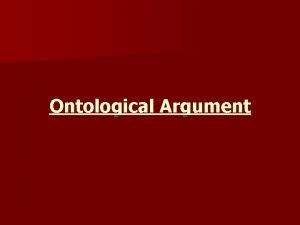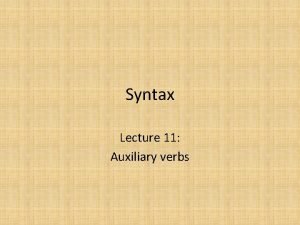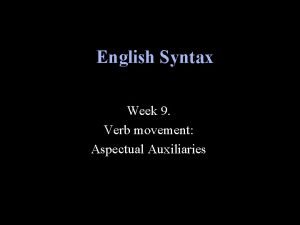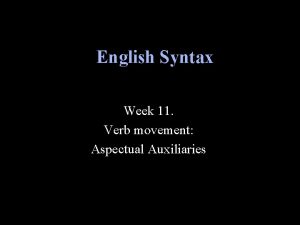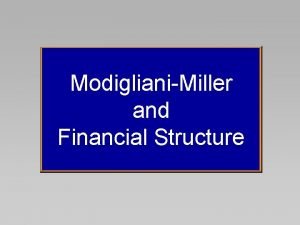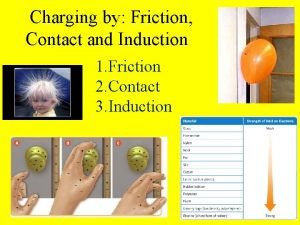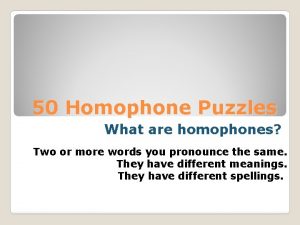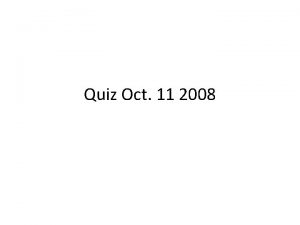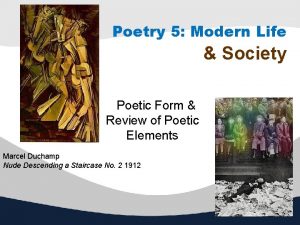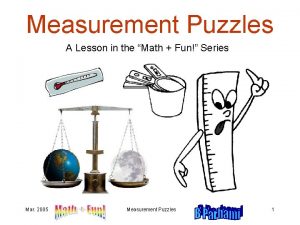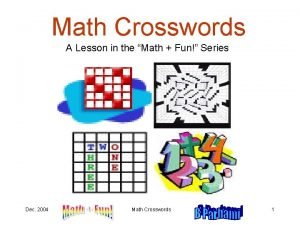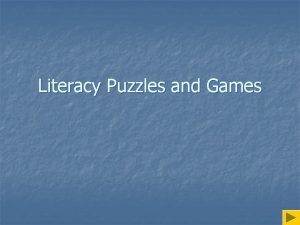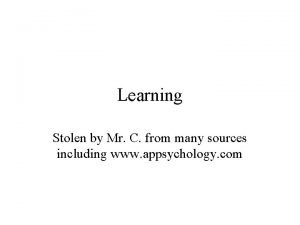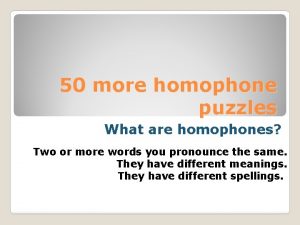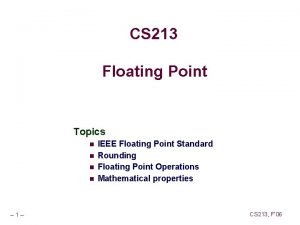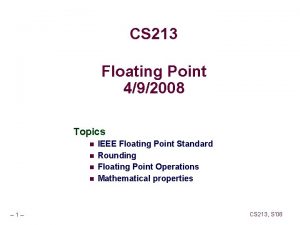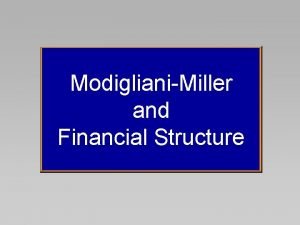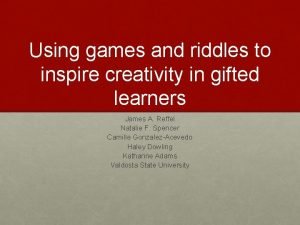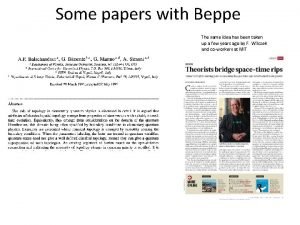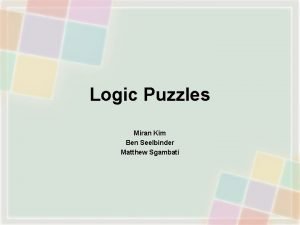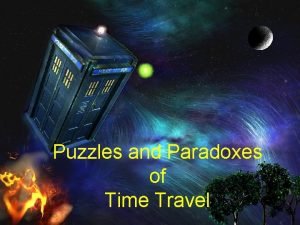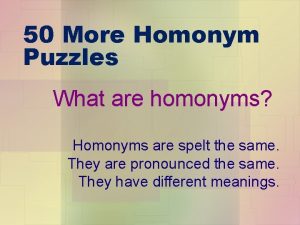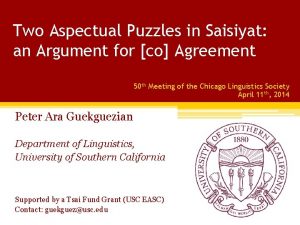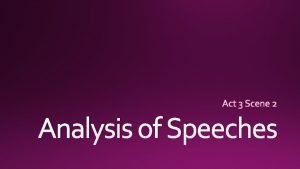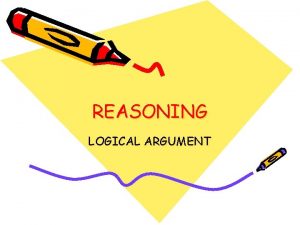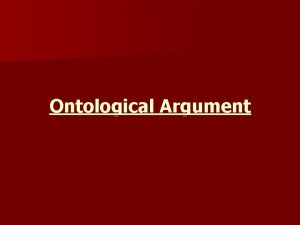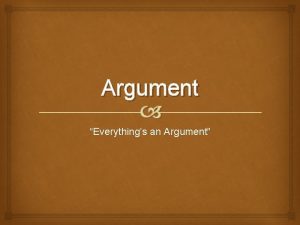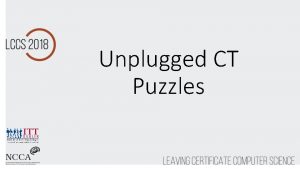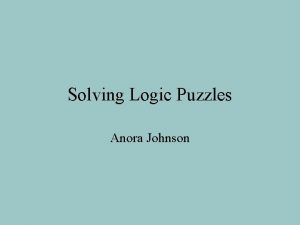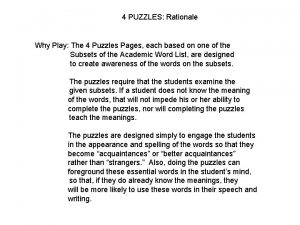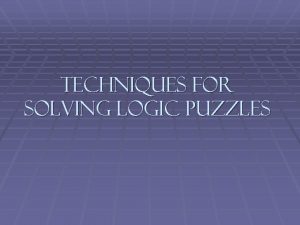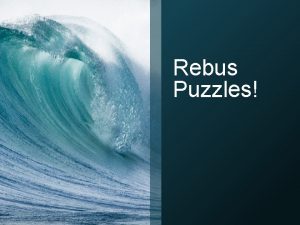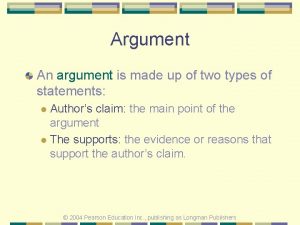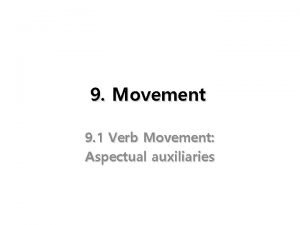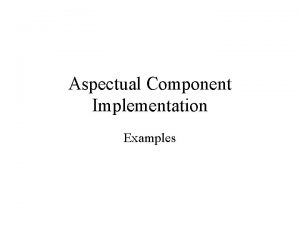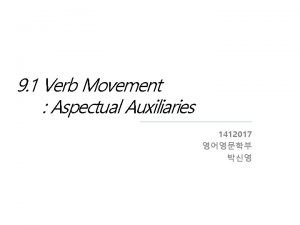Two Aspectual Puzzles in Saisiyat an Argument for
![Two Aspectual Puzzles in Saisiyat: an Argument for [co] Agreement 50 th Meeting of Two Aspectual Puzzles in Saisiyat: an Argument for [co] Agreement 50 th Meeting of](https://slidetodoc.com/presentation_image_h/abe6cff4fa796d51ab6deae7104585a6/image-1.jpg)

![Two Aspectual Puzzles • I focus on two puzzles with the aspectual markers [ila] Two Aspectual Puzzles • I focus on two puzzles with the aspectual markers [ila]](https://slidetodoc.com/presentation_image_h/abe6cff4fa796d51ab6deae7104585a6/image-3.jpg)
![[ila] Ambiguity • Scenario: Ataw has fallen sick on Monday and remains sick for [ila] Ambiguity • Scenario: Ataw has fallen sick on Monday and remains sick for](https://slidetodoc.com/presentation_image_h/abe6cff4fa796d51ab6deae7104585a6/image-4.jpg)
![Perfective [ina] • The aspectual marker [ina] is a perfective, indicating that a state Perfective [ina] • The aspectual marker [ina] is a perfective, indicating that a state](https://slidetodoc.com/presentation_image_h/abe6cff4fa796d51ab6deae7104585a6/image-5.jpg)
![[ina] -> Terminative • However, many predicates that are usually telic in other languages [ina] -> Terminative • However, many predicates that are usually telic in other languages](https://slidetodoc.com/presentation_image_h/abe6cff4fa796d51ab6deae7104585a6/image-6.jpg)
![[ila] -> Culminative • With [ila], these predicates usually give culminative readings (though a [ila] -> Culminative • With [ila], these predicates usually give culminative readings (though a](https://slidetodoc.com/presentation_image_h/abe6cff4fa796d51ab6deae7104585a6/image-7.jpg)
![Puzzle One: [ila] is Perfect • One of [ila]’s two readings is a U-Perfect, Puzzle One: [ila] is Perfect • One of [ila]’s two readings is a U-Perfect,](https://slidetodoc.com/presentation_image_h/abe6cff4fa796d51ab6deae7104585a6/image-8.jpg)



![Account So Far: Puzzle One • [ila] is a perfect marker that sets up Account So Far: Puzzle One • [ila] is a perfect marker that sets up](https://slidetodoc.com/presentation_image_h/abe6cff4fa796d51ab6deae7104585a6/image-12.jpg)



![Account So Far: Puzzle Two • [ila] is a perfect marker, [ina] a perfective Account So Far: Puzzle Two • [ila] is a perfect marker, [ina] a perfective](https://slidetodoc.com/presentation_image_h/abe6cff4fa796d51ab6deae7104585a6/image-16.jpg)

![[ina] + [ila]: Experiential Perfect • When [ina] and [ila] co-occur, they give an [ina] + [ila]: Experiential Perfect • When [ina] and [ila] co-occur, they give an](https://slidetodoc.com/presentation_image_h/abe6cff4fa796d51ab6deae7104585a6/image-18.jpg)
![[ina] + [ila]: Experiential Perfect • The E-perfect reading is the expected outcome of [ina] + [ila]: Experiential Perfect • The E-perfect reading is the expected outcome of](https://slidetodoc.com/presentation_image_h/abe6cff4fa796d51ab6deae7104585a6/image-19.jpg)
![Generalization: [ila] and [ina] • Different predicates combining with either [ila] or [ina] (or Generalization: [ila] and [ina] • Different predicates combining with either [ila] or [ina] (or](https://slidetodoc.com/presentation_image_h/abe6cff4fa796d51ab6deae7104585a6/image-20.jpg)
![Coincidence: [+/-co] • I adopt the idea of a coincidence relationship encoded in syntax Coincidence: [+/-co] • I adopt the idea of a coincidence relationship encoded in syntax](https://slidetodoc.com/presentation_image_h/abe6cff4fa796d51ab6deae7104585a6/image-21.jpg)
![Coincidence: [+/-co] • I build on the proposal of Demirdache and Uribe -Etxevarria (2000, Coincidence: [+/-co] • I build on the proposal of Demirdache and Uribe -Etxevarria (2000,](https://slidetodoc.com/presentation_image_h/abe6cff4fa796d51ab6deae7104585a6/image-22.jpg)


![Adding [co] to Account • Perfect [ila] with [+co] Viewpoint: U-Perfect • Perfect [ila] Adding [co] to Account • Perfect [ila] with [+co] Viewpoint: U-Perfect • Perfect [ila]](https://slidetodoc.com/presentation_image_h/abe6cff4fa796d51ab6deae7104585a6/image-25.jpg)
![[co] Agreement and Licensing • I propose that the [co] feature of covert heads [co] Agreement and Licensing • I propose that the [co] feature of covert heads](https://slidetodoc.com/presentation_image_h/abe6cff4fa796d51ab6deae7104585a6/image-26.jpg)
![Experential vs. Resultative Perfect • [ina] and the covert [-co] Viewpoint head have different Experential vs. Resultative Perfect • [ina] and the covert [-co] Viewpoint head have different](https://slidetodoc.com/presentation_image_h/abe6cff4fa796d51ab6deae7104585a6/image-27.jpg)

![Complete Account of Readings • The ambiguity of [ila] is due to lower [+/-co] Complete Account of Readings • The ambiguity of [ila] is due to lower [+/-co]](https://slidetodoc.com/presentation_image_h/abe6cff4fa796d51ab6deae7104585a6/image-29.jpg)
![[ila]: Universal Perfect • Perfect [ila] with [+co] covert Viewpoint and [+co] predicate: U-Perfect [ila]: Universal Perfect • Perfect [ila] with [+co] covert Viewpoint and [+co] predicate: U-Perfect](https://slidetodoc.com/presentation_image_h/abe6cff4fa796d51ab6deae7104585a6/image-30.jpg)
![[ila]: Resultative Perfect • Perfect [ila] with [-co] covert Viewpoint and Aktionsart: Resultative E-Perfect [ila]: Resultative Perfect • Perfect [ila] with [-co] covert Viewpoint and Aktionsart: Resultative E-Perfect](https://slidetodoc.com/presentation_image_h/abe6cff4fa796d51ab6deae7104585a6/image-31.jpg)
![[ina]: Terminative • Perfective [ina] with [+co] predicate: Terminative reading ▫ ‘was sick/walked/drank wine [ina]: Terminative • Perfective [ina] with [+co] predicate: Terminative reading ▫ ‘was sick/walked/drank wine](https://slidetodoc.com/presentation_image_h/abe6cff4fa796d51ab6deae7104585a6/image-32.jpg)
![[ina]+[ila]: Experiential Perfect • Perfect [ila] with perfective [ina] and [+co] predicate: Experiential E-Perfect [ina]+[ila]: Experiential Perfect • Perfect [ila] with perfective [ina] and [+co] predicate: Experiential E-Perfect](https://slidetodoc.com/presentation_image_h/abe6cff4fa796d51ab6deae7104585a6/image-33.jpg)


- Slides: 35
![Two Aspectual Puzzles in Saisiyat an Argument for co Agreement 50 th Meeting of Two Aspectual Puzzles in Saisiyat: an Argument for [co] Agreement 50 th Meeting of](https://slidetodoc.com/presentation_image_h/abe6cff4fa796d51ab6deae7104585a6/image-1.jpg)
Two Aspectual Puzzles in Saisiyat: an Argument for [co] Agreement 50 th Meeting of the Chicago Linguistics Society April 11 th, 2014 Peter Ara Guekguezian Department of Linguistics, University of Southern California Supported by a Tsai Fund Grant (USC EASC) Contact: guekguez@usc. edu

Goals of Presentation • I provide new data on tense and aspect from Saisiyat, a highly endangered Austronesian language of Taiwan • I advocate for a version of the Extended Now theory of the perfect laid out in Iatridou et al (2001) • I propose an account driven by agreement and licensing of the syntactic feature [coincidence] ([co]) ▫ Covert heads need to have their [co] value licensed by an overt head Guekguezian, CLS 50 2
![Two Aspectual Puzzles I focus on two puzzles with the aspectual markers ila Two Aspectual Puzzles • I focus on two puzzles with the aspectual markers [ila]](https://slidetodoc.com/presentation_image_h/abe6cff4fa796d51ab6deae7104585a6/image-3.jpg)
Two Aspectual Puzzles • I focus on two puzzles with the aspectual markers [ila] and [ina] • First puzzle: [ila] results in ambiguity between a Universal (U-) Perfect and an Inchoative • Second puzzle: many predicates that might be expected to give culminative readings with [ina] give terminative readings instead ▫ These predicates give culminative readings with [ila] instead Guekguezian, CLS 50 3
![ila Ambiguity Scenario Ataw has fallen sick on Monday and remains sick for [ila] Ambiguity • Scenario: Ataw has fallen sick on Monday and remains sick for](https://slidetodoc.com/presentation_image_h/abe6cff4fa796d51ab6deae7104585a6/image-4.jpg)
[ila] Ambiguity • Scenario: Ataw has fallen sick on Monday and remains sick for the rest of the week, (1) is appropriate on both Monday (when he becomes sick) and on Friday (when he is still sick) (1) Ataw ‘ayaeh ila Ataw sick ILA “Ataw fell sick” (Inchoative) or “Ataw has been sick (and still is)” (U-Perfect) • This ambiguity appears with many predicates (e. g. , ‘(be) fat’, ‘(be) skinny’, ‘sleep’, ‘walk’, ‘hit the dog’) Guekguezian, CLS 50 4
![Perfective ina The aspectual marker ina is a perfective indicating that a state Perfective [ina] • The aspectual marker [ina] is a perfective, indicating that a state](https://slidetodoc.com/presentation_image_h/abe6cff4fa796d51ab6deae7104585a6/image-5.jpg)
Perfective [ina] • The aspectual marker [ina] is a perfective, indicating that a state or event occurred in the past and is now finished (2) Ataw ina ‘ayaeh Ataw INA sick “Ataw was sick (once but no longer is)” (3) Ataw ina m-anra: an Ataw INA AF-walk “Ataw walked (once but no longer does)” Guekguezian, CLS 50 5
![ina Terminative However many predicates that are usually telic in other languages [ina] -> Terminative • However, many predicates that are usually telic in other languages](https://slidetodoc.com/presentation_image_h/abe6cff4fa796d51ab6deae7104585a6/image-6.jpg)
[ina] -> Terminative • However, many predicates that are usually telic in other languages can give terminative readings with [ina] ▫ Telic predicates typically give culminative readings with perfective viewpoint (4) Ataw ina r<om>ae’oe’ ka pinobaeh Ataw INA <AF>drink KA wine “Ataw drank (some) wine (but did not finish)” (5) Ataw ina ‘<oem>leb kate. Snenan Ataw INA <AF>close door “Ataw (tried to) close the door (unsuccessfully)” Guekguezian, CLS 50 6
![ila Culminative With ila these predicates usually give culminative readings though a [ila] -> Culminative • With [ila], these predicates usually give culminative readings (though a](https://slidetodoc.com/presentation_image_h/abe6cff4fa796d51ab6deae7104585a6/image-7.jpg)
[ila] -> Culminative • With [ila], these predicates usually give culminative readings (though a U-Perfect reading is often available, if not salient) (6) Ataw r<om>ae’oe’ ila ka pinobaeh Ataw <AF>drink ILA KA wine “Ataw drunk up the wine” (7) Ataw ‘<oem>leb ila kate. Snenan Ataw <AF>close ILA door “Ataw closed the door (successfully)” Guekguezian, CLS 50 7
![Puzzle One ila is Perfect One of ilas two readings is a UPerfect Puzzle One: [ila] is Perfect • One of [ila]’s two readings is a U-Perfect,](https://slidetodoc.com/presentation_image_h/abe6cff4fa796d51ab6deae7104585a6/image-8.jpg)
Puzzle One: [ila] is Perfect • One of [ila]’s two readings is a U-Perfect, so I assume that [ila] has perfect semantics • Three main types of perfect: ▫ U-perfect: “Mary has been sleeping since noon” ▫ Experiential: “Mary has seen the Eiffel Tower” ▫ Resultative: “Mary has lost her glasses” • The Experiential and Resultative are versions of the Existential (E-)Perfect Guekguezian, CLS 50 8

Theories of the Perfect • The three major theories of the perfect focus on different readings ▫ Anteriority: event time occurs before a reference time point, which itself stands in relation to the evaluation time (e. g. , Hornstein 1990) ▫ Result State: the relevance at evaluation time of a result state issuing from the end of the event (e. g. , Parsons 1990) ▫ Extended Now: the evaluation time is considered to extend into the past, within or throughout which time span the event occurs (e. g. , Mc. Coard 1978) Guekguezian, CLS 50 9

Perfect Time Span • I adopt the version of the Extended Now theory outlined in Iatridou et al (2001), which relates the event time with respect to the Perfect Time Span (PTS) ▫ The right boundary (RB) of the PTS is evaluation time, while the left boundary (LB) is set by a temporal adverbial (either overt or covert) Guekguezian, CLS 50 10

PTS + Viewpoint: U- vs. E-Perfect • Combining the PTS with Viewpoint derives the difference between the U- and E-perfects ▫ Imperfective Viewpoint: event time is a superset of the PTS, so the event obtains throughout, giving the U-Perfect ▫ Perfective Viewpoint, event time is a subset of the PTS, so the event obtains for some of the PTS, giving the E-Perfect Guekguezian, CLS 50 11
![Account So Far Puzzle One ila is a perfect marker that sets up Account So Far: Puzzle One • [ila] is a perfect marker that sets up](https://slidetodoc.com/presentation_image_h/abe6cff4fa796d51ab6deae7104585a6/image-12.jpg)
Account So Far: Puzzle One • [ila] is a perfect marker that sets up the PTS: the ambiguity is due to different Viewpoint aspects (3) Ataw ‘ayaeh ila + Imperfective -> U-Perfect (4) Ataw ‘ayaeh ila + Perfective -> E-Perfect PTS: LB ---------- RB (=Eval. T) Perfective: (----) E-Perfect Imperfective: (--------------) U-Perfect Guekguezian, CLS 50 12

Account So Far: Puzzle One • Unresolved question #1: why is the second reading of [ila] an Inchoative, and not (seemingly) an E-perfect? E. g. , ▫ Why is (4) “Ataw fell sick” and not “Ataw has been sick (once)” Guekguezian, CLS 50 13

Puzzle Two: Telicity and VPs • Languages vary as to how to encode telicity: ▫ Some (e. g. , English, Romance) usually encode telicity in the VP, by the composition of the verb and its object DP (Krifka 1989, 1992) ▫ Others (e. g. , Russian, Mandarin, Tagalog) usually encode telicity by independent syntactic heads (e. g. , aspectual morphology; Kratzer 2003, Tai 1984, Travis 2000) • I posit that Saisiyat also encodes telicity by an independent syntactic head Guekguezian, CLS 50 14

Atelic VPs + Telic Head • I propose that most VPs in Saisiyat are atelic, and thus yield terminative and not culminative readings with the perfective [ina] • Telicity is encoded by a covert Aktionsart head ▫ [ila] requires the presence of this head to give a culminative reading (as opposed to a U-perfect) • I argue that the inchoative reading of [ila] is also due to this covert telic head ▫ Telic morphology can derive inchoatives from atelic predicates (Smith 1991 for Russian and Mandarin, Filip 1997 for Czech) Guekguezian, CLS 50 15
![Account So Far Puzzle Two ila is a perfect marker ina a perfective Account So Far: Puzzle Two • [ila] is a perfect marker, [ina] a perfective](https://slidetodoc.com/presentation_image_h/abe6cff4fa796d51ab6deae7104585a6/image-16.jpg)
Account So Far: Puzzle Two • [ila] is a perfect marker, [ina] a perfective • Most VPs in Saisiyat are atelic by default; telicity is marked by a covert head ▫ [ina] with atelic VPs gives a terminative reading ▫ [ila] with the telic marker gives an inchoative or culminative reading, depending on the semantics of the predicate Guekguezian, CLS 50 16

Account So Far: Puzzle Two • Unresolved question #2: what regulates when the covert telic head can appear? E. g. , ▫ Why are culminative and inchoative readings (mostly) restricted to occurring with [ila], and not with [ina] or the lack of an aspectual marker? Guekguezian, CLS 50 17
![ina ila Experiential Perfect When ina and ila cooccur they give an [ina] + [ila]: Experiential Perfect • When [ina] and [ila] co-occur, they give an](https://slidetodoc.com/presentation_image_h/abe6cff4fa796d51ab6deae7104585a6/image-18.jpg)
[ina] + [ila]: Experiential Perfect • When [ina] and [ila] co-occur, they give an Experiential E-perfect reading (8) Ataw ina ‘ayaeh ila Ataw INA sick ILA “Ataw has been sick (once)” (9) Ataw ina r<om>ae’oe’ ila ka pinobaeh Ataw INA <AF>drink ILA KA wine “Ataw has drunk some/the wine (once)” Guekguezian, CLS 50 18
![ina ila Experiential Perfect The Eperfect reading is the expected outcome of [ina] + [ila]: Experiential Perfect • The E-perfect reading is the expected outcome of](https://slidetodoc.com/presentation_image_h/abe6cff4fa796d51ab6deae7104585a6/image-19.jpg)
[ina] + [ila]: Experiential Perfect • The E-perfect reading is the expected outcome of combining the perfect [ila] with perfective [ina] in PTS theory • Unresolved question #3: why is this E-perfect an Experiential, rather than an Inchoative (as when [ila] occurs without [ina])? Guekguezian, CLS 50 19
![Generalization ila and ina Different predicates combining with either ila or ina or Generalization: [ila] and [ina] • Different predicates combining with either [ila] or [ina] (or](https://slidetodoc.com/presentation_image_h/abe6cff4fa796d51ab6deae7104585a6/image-20.jpg)
Generalization: [ila] and [ina] • Different predicates combining with either [ila] or [ina] (or both) Predicate: ‘sick’, ‘sleep’, ‘walk’, ‘hit the dog’ Aspect Marker: (inherently atelic) ‘drink the wine’, ‘close the door’ (inherently telic? ? ? ) [ila] Inchoative; Universal Perfect Culminative; Universal Perfect* [ina] Terminative** [ina] + [ila] Experiential Perfect * The U-Perfect reading is harder to observe for these predicates than with the others ** A culminative reading is possible with these predicates, but is not necessary Guekguezian, CLS 50 20
![Coincidence co I adopt the idea of a coincidence relationship encoded in syntax Coincidence: [+/-co] • I adopt the idea of a coincidence relationship encoded in syntax](https://slidetodoc.com/presentation_image_h/abe6cff4fa796d51ab6deae7104585a6/image-21.jpg)
Coincidence: [+/-co] • I adopt the idea of a coincidence relationship encoded in syntax (Hale 1984) ▫ Central coincidence ([+co]): one linguistic object is at or (with)in another ▫ Non-central coincidence ([-co]): one linguistic object is not in/at (e. g. , away from or toward) another Guekguezian, CLS 50 21
![Coincidence co I build on the proposal of Demirdache and Uribe Etxevarria 2000 Coincidence: [+/-co] • I build on the proposal of Demirdache and Uribe -Etxevarria (2000,](https://slidetodoc.com/presentation_image_h/abe6cff4fa796d51ab6deae7104585a6/image-22.jpg)
Coincidence: [+/-co] • I build on the proposal of Demirdache and Uribe -Etxevarria (2000, 2003, 2007) to extend coincidence into the temporal and aspectual domain ▫ [+co]: Present Tense; Progressive Aspect ▫ [-co]: Past and Future Tense; Retro- and Prospective Aspect Guekguezian, CLS 50 22

Coincidence and Aspect • While I do not follow the specifics of this proposal, I utilize the insight that tenses and aspects are [+/-co] relations between time (Zeit -)phrases • I suggest that coincidence (specifically, containment) in the domain of aspect is equivalent to boundedness ▫ ‘contains’=‘is a superset of’=‘is not bounded by’ ▫ ‘does not contain’=‘is a subset of’=‘is bounded by’ Guekguezian, CLS 50 23

Coincidence and Aspect • Viewpoint Aspect (relates event to reference time) ▫ Event not bounded by reference time: imperfective [+co] ▫ Event bounded by reference time: perfective [-co] • Aktionsart (structures event internally) ▫ Event not bounded in structure: atelic [+co] ▫ Event bounded in structure: telic [-co] Guekguezian, CLS 50 24
![Adding co to Account Perfect ila with co Viewpoint UPerfect Perfect ila Adding [co] to Account • Perfect [ila] with [+co] Viewpoint: U-Perfect • Perfect [ila]](https://slidetodoc.com/presentation_image_h/abe6cff4fa796d51ab6deae7104585a6/image-25.jpg)
Adding [co] to Account • Perfect [ila] with [+co] Viewpoint: U-Perfect • Perfect [ila] with [-co] Viewpoint: E-Perfect ▫ Viewpoint heads can be covert • Perfective [ina]: [-co] Viewpoint ▫ Perfect [ila] with perfective [ina]: E-Perfect • The covert telic head bears a [-co] feature • Predicates (atelic by default) bear a [+co] feature Guekguezian, CLS 50 25
![co Agreement and Licensing I propose that the co feature of covert heads [co] Agreement and Licensing • I propose that the [co] feature of covert heads](https://slidetodoc.com/presentation_image_h/abe6cff4fa796d51ab6deae7104585a6/image-26.jpg)
[co] Agreement and Licensing • I propose that the [co] feature of covert heads must be licensed by the matching feature of an overt head ▫ [ila] is underspecified for [co] (i. e. , it can be [+co] or [-co]) and licenses both [+co] and [-co] covert heads ▫ In the absence of an overt aspectual marker, neither covert [-co] Viewpoint or Aktionsart can appear ▫ Covert [+co] Viewpoint is licensed by the overt [+co] predicate Guekguezian, CLS 50 26
![Experential vs Resultative Perfect ina and the covert co Viewpoint head have different Experential vs. Resultative Perfect • [ina] and the covert [-co] Viewpoint head have different](https://slidetodoc.com/presentation_image_h/abe6cff4fa796d51ab6deae7104585a6/image-27.jpg)
Experential vs. Resultative Perfect • [ina] and the covert [-co] Viewpoint head have different semantics ▫ [ina] asserts that the event time interval is a proper subset of the reference time interval ▫ Covert [-co] Viewpoint asserts that an event boundary (not the entire interval) is a proper subset of the reference time ▫ This head must combine with [-co] telic Aktionsart, so it can take an event boundary argument Guekguezian, CLS 50 27

Experential vs. Resultative Perfect • Inchoatives and Culminatives are Resultative Eperfects, the outcome of combining [ila] with the covert [-co] Viewpoint head PTS: LB ---------- RB (=Eval. T) Ø[-co]: B(--Result State--) Resultative Ina[-co]: (-----) Experiential Ø[+co]: (---------------) Universal Guekguezian, CLS 50 28
![Complete Account of Readings The ambiguity of ila is due to lower co Complete Account of Readings • The ambiguity of [ila] is due to lower [+/-co]](https://slidetodoc.com/presentation_image_h/abe6cff4fa796d51ab6deae7104585a6/image-29.jpg)
Complete Account of Readings • The ambiguity of [ila] is due to lower [+/-co] covert aspectual heads Perfect Viewpoint Aktionsart Reading ila[+co] Ø[+co] (from VP) Universal Perfect ila[-co] Ø[-co] Resultative Perfect (Inchoative/Culminative) Ø ina[-co] [+co] (from VP) Terminative ila[+/-co] ina[-co] [+co] (from VP) Experiential Perfect Guekguezian, CLS 50 29
![ila Universal Perfect Perfect ila with co covert Viewpoint and co predicate UPerfect [ila]: Universal Perfect • Perfect [ila] with [+co] covert Viewpoint and [+co] predicate: U-Perfect](https://slidetodoc.com/presentation_image_h/abe6cff4fa796d51ab6deae7104585a6/image-30.jpg)
[ila]: Universal Perfect • Perfect [ila] with [+co] covert Viewpoint and [+co] predicate: U-Perfect reading ▫ ‘has been sick/walking/drinking wine’’ Guekguezian, CLS 50 30
![ila Resultative Perfect Perfect ila with co covert Viewpoint and Aktionsart Resultative EPerfect [ila]: Resultative Perfect • Perfect [ila] with [-co] covert Viewpoint and Aktionsart: Resultative E-Perfect](https://slidetodoc.com/presentation_image_h/abe6cff4fa796d51ab6deae7104585a6/image-31.jpg)
[ila]: Resultative Perfect • Perfect [ila] with [-co] covert Viewpoint and Aktionsart: Resultative E-Perfect reading ▫ Inchoative: ‘has fallen sick/started to walk’ ▫ Culminative: ‘has drunk up the wine’ Guekguezian, CLS 50 31
![ina Terminative Perfective ina with co predicate Terminative reading was sickwalkeddrank wine [ina]: Terminative • Perfective [ina] with [+co] predicate: Terminative reading ▫ ‘was sick/walked/drank wine](https://slidetodoc.com/presentation_image_h/abe6cff4fa796d51ab6deae7104585a6/image-32.jpg)
[ina]: Terminative • Perfective [ina] with [+co] predicate: Terminative reading ▫ ‘was sick/walked/drank wine (once)’ Guekguezian, CLS 50 32
![inaila Experiential Perfect Perfect ila with perfective ina and co predicate Experiential EPerfect [ina]+[ila]: Experiential Perfect • Perfect [ila] with perfective [ina] and [+co] predicate: Experiential E-Perfect](https://slidetodoc.com/presentation_image_h/abe6cff4fa796d51ab6deae7104585a6/image-33.jpg)
[ina]+[ila]: Experiential Perfect • Perfect [ila] with perfective [ina] and [+co] predicate: Experiential E-Perfect ▫ ‘has been sick/walked/drunk wine (once)’ Guekguezian, CLS 50 33

Summary of Contributions • This account of two aspectual puzzles in Saisiyat has made several contributions to theory of aspect: ▫ Provided evidence in support of the Perfect Time Span theory from an underdescribed language The Perfect Time Span is needed to account for the ambiguity between Universal and Existential perfects Guekguezian, CLS 50 34

Summary of Contributions • Extended the Perfect Time Span theory to account for the Resultative Perfect (cf. Pancheva 2003) • Extended theory of coincidence in the aspectual domain to include Aktionsart • Demonstrated the efficacy of using [co] feature agreement and licensing between aspectual heads Guekguezian, CLS 50 35
 Argument för teckenspråk som minoritetsspråk
Argument för teckenspråk som minoritetsspråk The ontological argument
The ontological argument Auxiliary syntax
Auxiliary syntax Perifrasis aspectuales ingresivas ejemplos
Perifrasis aspectuales ingresivas ejemplos Aspectual auxiliaries
Aspectual auxiliaries Aspectual auxiliaries
Aspectual auxiliaries Complexo verbal exemplos
Complexo verbal exemplos Eight basic puzzles about financial structure
Eight basic puzzles about financial structure Stars dogs plowhorses and puzzles
Stars dogs plowhorses and puzzles Applications of propositional logic in discrete mathematics
Applications of propositional logic in discrete mathematics Pith ball puzzles
Pith ball puzzles Homophone of ceiling
Homophone of ceiling Homonym of pen
Homonym of pen Jiggsaw puzzle
Jiggsaw puzzle With up so floating many bells down
With up so floating many bells down Measurement puzzles
Measurement puzzles Math crosswords
Math crosswords Literacy puzzles
Literacy puzzles Variable interval
Variable interval Nonverbal index wisc-v
Nonverbal index wisc-v Homophone puzzles
Homophone puzzles Likes dislikes puzzles connections grid
Likes dislikes puzzles connections grid Floating point puzzles
Floating point puzzles Floating point puzzles
Floating point puzzles Floating point puzzles
Floating point puzzles Eight basic puzzles about financial structure
Eight basic puzzles about financial structure Patchwords puzzles
Patchwords puzzles Beppe puzzles
Beppe puzzles Goldman sachs puzzles
Goldman sachs puzzles Logic puzzles
Logic puzzles Time travel paradox
Time travel paradox Blockhead bill
Blockhead bill 50 homonyms with meaning
50 homonyms with meaning Kontinuitetshantering i praktiken
Kontinuitetshantering i praktiken Novell typiska drag
Novell typiska drag Nationell inriktning för artificiell intelligens
Nationell inriktning för artificiell intelligens

